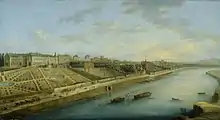Hôtel de Valentinois
The Hôtel de Valentinois was an hôtel particulier, a kind of large townhouse of France, in Passy, bordering at its greatest extent present-day Rue Raynouard, present-day Rue des Vignes (opposite to Château de Passy), Rue Bois-le-Vent,[2] to present-day Rue de l'Annonciation.[2]
.jpg.webp)
.jpg.webp)

The Hôtel was last owned by Jacques-Donatien Le Ray de Chaumont, who bought it in 1776 and rented to Benjamin Franklin the dwelling appending by the orangery, and eventually the eastern pavilion of the Hôtel.[3]
Le Ray de Chaumont sold the Hôtel as three different lots.[4]
Auguste Doniol's claim that in June 1837 the Brothers of the Christian Schools bought "les deux pavillons" (supposedly those bordering present-day Rue Raynouard), and a part of the gardens, from "M. Briant"[5] seems to conflict with Henri Bouchot's claim that Briant had owned "the back premises" (likely the orangery and adjoined buildings) "and kitchen-garden", while "the greater part, the house with the colonnades, the terraces and garden" had been owned by "writer and politician, Claude Fulchiron of Lyons",[4] and with claims that these passed in 1811, at least in part, to banker Isaac-Louis Grivel's daughter Anne-Marie, and were sold by her husband Charles Vernes to the Brothers in 1836,[6] another part having been bought by industrialist David Singer and opened with a street bearing his name as early as 1836.[7]
A "third lot" had fallen "to Du Mersan, the gay dramatist", comprising the commons and some remains of the garden[4] (likely a southwestern part of it, visible on the Roussel map of Paris and its faubourgs and surroundings but not shown on the Guélin plan of the Hôtel).
On 8 April 1839, the Brothers transferred a boarding school for boys which they had opened at 165 Rue du Faubourg Saint-Martin to facilities which they had specially built on their lot of the Hôtel's grounds and possibly facilities of the allotted Hôtel which they had preserved,[8] and which became known as "le Pensionnat des Frères des écoles chrétiennes à Passy". In the following decades, the Brothers would rebuild some of the school's facilities and expand other ones,[9] the school buildings bordering eventually, if not from the day of its opening in Passy, all of the segment of present-day Rue Raynouard running from the corner of present-day Rue Singer to that of present-day Rue des Vignes.
Notes
References
- D***, p. 17.
- Simon, Davray-Piekolek, Lacour-Veyranne & Dole, p. 119.
- Allan, Orsoni, Inguenaud, Dainard & Smith (ed.), pp. 15 & 50.
- Bouchot, p. 196.
- Doniol, p. 42.
- Schaeper, p. 333.
- Hillairet, p. 74.
- Annuaire, p. 91; Doniol, p. 42.
- Annuaire, p. 92.
Sources
- Allan, Peter; Orsoni, Jean; Inguenaud, Marie-Thérèse; Dainard, J. A.; Smith, David, ed. (1998). Correspondance générale d'Helvétius. Volume 4. University of Toronto Press.
- Annuaire administratif, industriel, statistique et commercial de Passy (1858).
- Bouchot, Henri (1889). "Franklin à Passy". Les lettres et les arts. Boussod, Valadon et cie.
- D*** (1779). Voyage pittoresque des environs de Paris.
- Doniol, Auguste (1902). Histoire du XVIe arrondissement de Paris. Hachette et cie.
- Hillairet, Jacques (1963). Connaissance du vieux Paris : les villages. Gonthier.
- Schaeper, Thomas J. (1995). France and America in the Revolutionary Era: the Life of Jacques-Donatien Leray de Chaumont (1725-1803).
- Simon, Miriam; Davray-Piekolek, Renée; Lacour-Veyranne, Charlotte; Dole, Christiane (2007). Benjamin Franklin : un Américain à Paris.